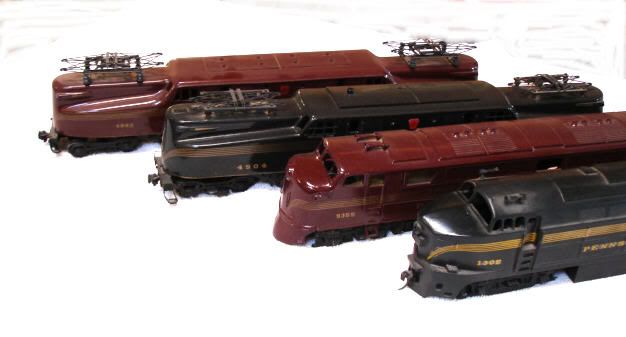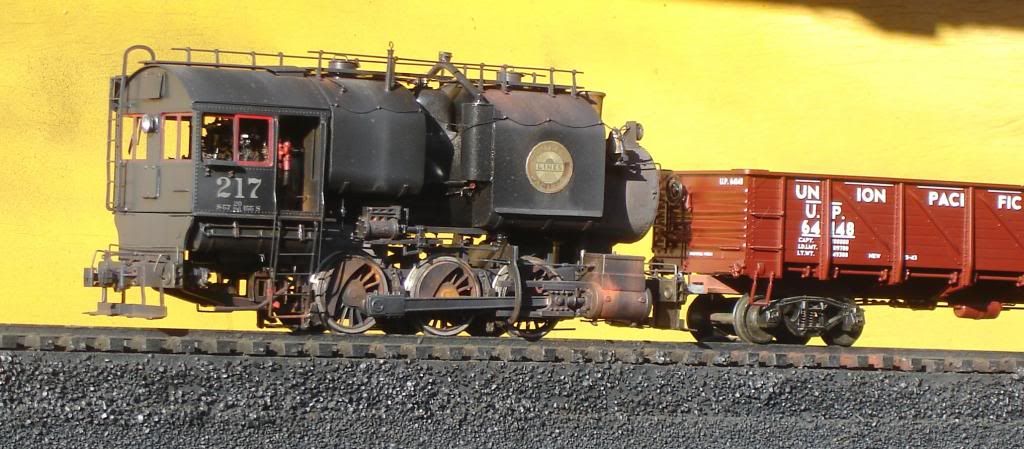Hello All---somewhere I'v read that others are using something else other than the brand Dullcote, when I read these things I should write down byt memory eludes me.
Replies sorted oldest to newest
I've used various hardware and art store spray cans of matt or flat clear finish. They work ok on large scale stuff but are not as fine as dull coat in the smaller spray can. The price is right however so I'd try some and see if you like it.......DaveB
thank you---will try--
Krylon No.1311 Matt Finish. It has a better spray than Testors.
You will find it at art and craft stores.
Also Testers makes a flat finish in the Model Masters line.
another thank you---thank you
In the same vein, any low-cost substitute for Testor's gloss coat?
To use on model cars and trucks. Must not attack water slide decals.
In the same vein, any low-cost substitute for Testor's gloss coat?
To use on model cars and trucks. Must not attack water slide decals.
Yes ![]() We use either KRYLON flat clear or KRYLON matte finish clear. We have been using these for many years and buy them by the case.
We use either KRYLON flat clear or KRYLON matte finish clear. We have been using these for many years and buy them by the case.![]()
Dave, LBR
What did Joel say in "Risky Business"???
_______ There is NO substitute!
![]()
I've tried em all, and always end up back at the bottles of Dull-Cote and a can of laquer thinner.
Tru-Color Paint TCP-017 Flat ![]()
Rust Oleum Matte Finish. No problems thus far.
Never use anything but Dullcote (cans) - now. The price is irrelevant - it's a custom paint/decal job, lots of work, on a $500 locomotive - if a $4.00 can of Dullcote is a problem,
well...
======
Have had paint compatibility issues with all the hardware store brands - especially Valspar
(ate one paint job alive). Also, my experience has been that they are not as "flat", typically.
A not-flat "flat" is not flat.
None of these problems are universal, but since I never knew when it would strike, I had to assume that it would always strike. I'm sure there are paints that Dullcote does not like, but have yet to find them.
Not a debate - just my life experience.
====
I wish that Testors would make a "Satincote". This can have uses, here and there.
"The price is irrelevant - it's a custom paint/decal job, lots of work, on a $500 locomotive"
but more often it's sealing some weathering on a $20 boxcar :>![]() If I'm doing an expensive model I certainly use an airbrush and hobby type flat coat but for lots of runners I don't bother. I've never had compatibility problems with spray cans since I mist them on lightly. Brushing something like lacquer over enamel is where it's more likely to craze the paint job, most times the sprayed stuff dries before it can do any harm.......DaveB
If I'm doing an expensive model I certainly use an airbrush and hobby type flat coat but for lots of runners I don't bother. I've never had compatibility problems with spray cans since I mist them on lightly. Brushing something like lacquer over enamel is where it's more likely to craze the paint job, most times the sprayed stuff dries before it can do any harm.......DaveB
"There is NO substitute"
DITTO - I tried Krylon clear flat and it still has a shine.
Lowes Valspar clear flat spray is close but not as good as Dullcote.
In the same vein, any low-cost substitute for Testor's gloss coat?
To use on model cars and trucks. Must not attack water slide decals.
I have been advised that Future liquid floor polish applied with an airbrush works great. I keep meaning to experiment with it on something insignificant.
Bruce
I use Future on a Q-tip to seal decals and accent gloss paint jobs. I used to use Floquil flat clear, but found that it was quite finicky about thinners. I have had Scale Coat clear eat underlying Scale Coat colors. I have not progressed to spraying Future - it is water- base, and requires techniques I am not yet good at.
These are all Scale Coat, then decals, then Future Floor Wax applied one direction only with a Q-tip.
Good to know that acceptable results can be had without the need for an airbrush. It would sure save on a lot of dis assembly and masking by applying it precisely where needed.
Bruce
The original Dio Sol Floquil flat was dead flat. The most recent version was not as flat but still less gloss than Dull Coat. If I want dead flat now I use Floquil Dust.
Pete
Dullcoat in the rattle can has been my go-to in the smaller scale (HO) for something like 40 years. Have never found a better substitute. I spray from the can into a small paper cup, then pour that into the airbrush bottle and airbrush it on. Better control than from the can, no build-up (unless you desire it to hide decal edges), and can be feathered on for setting weathering chalks if needed. Easy.
I haven't had to purchase a Dullcoat rattle can in a few years... IS it still available?
"I haven't had to purchase a Dullcoat rattle can in a few years... IS it still available?'
As far a I know it still is. I had to buy a can a few years ago. I don't use solvent based paints in my airbrush any more ( don't like to clean it with solvents) and I found that water based flat clear coats made my gel pen graffiti run so I needed to use solvent based rattle cans to seal the weathering. The big hardware store cans worked fine on my O and S stuff but the first time I tried them on an N scale car the spray blast knocked it over on it's side. So I bought a can of dull coat( marked Testors 1260 flat clear lacquer) and it's still going since those N scale cars take so little paint.....DaveB
Don't get the idea that my PRR stuff above was not airbrushed. Those things are finished to a very high gloss witha multiple coats of Scale Coat applied with a Paasche, sanded with 600 wet sandpaper between. They have to be dead- smooth, and totally glossy, or film decals won't work.
The Future is applied carefully over the entire body - it is, after all, a floor wax. Think of the Q-tip as a tiny mop, and do not over-do it. Just get the surface wet, or it will sag, and make you unhappy. You can buff it afterward, although that is not necessary.
For steam, I do the exact same thing, then a coat of dull clear, then chalk and weathering, then a final dull coat, all with the Paasche except for the Future.
Have had paint compatibility issues with all the hardware store brands - especially Valspar
Same here, don't use it!
I've been using the Krylon Clear Gloss and Clear Matte for a while now, Walmart carries it.
They have to be dead- smooth, and totally glossy, or film decals won't work.
That is not true at all.
Before the modeling world posted the "glossy" myth, for decades I had perfectly good results decalling on non-gloss surfaces. A glossy surface may make things a bit easier, but as for the "won't work" part, that is just not true.
"That is not true at all."
Well, it is and it isn't. The surface doesn't have to be glossy but it has to be smooth and most gloss coats are smoother than flat coats when viewed at the microscopic level. The tiny roughness of flat coats lets air stay under the decal and makes the white blush seen on most rough surface decal jobs. So a smooth paint like the old floquil "flat" (which was really a satin style) works fine or one can just decal on a flat paint by spreading a drop of future finish out where the decal is to go and then applying the decal on the wet future. The future fills the tiny voids and leaves no place for the air to hide. Future also allows one to decal over bare plastic by increasing the bond strength so the decals won't scrape off later. It's great stuff and a jug lasts for years.....DaveB
I recently used Tamiya TS-80 Clear Flat spray as a substitute for Dullcoat spray. I am very happy with the results. Nice, even flat finish over Scalecoat II enamel.
Stuart
It is definitely true for me - I get vastly different results over glossy finishes - the decal film simply disappears, and the decals look like pad print. I have an AC-4 where i got lazy, and I regret my laziness every time I look at the cab number.
"That is not true at all."
Well, it is and it isn't. The surface doesn't have to be glossy but it has to be smooth and most gloss coats are smoother than flat coats when viewed at the microscopic level. The tiny roughness of flat coats lets air stay under the decal and makes the white blush seen on most rough surface decal jobs. So a smooth paint like the old floquil "flat" (which was really a satin style) works fine or one can just decal on a flat paint by spreading a drop of future finish out where the decal is to go and then applying the decal on the wet future. The future fills the tiny voids and leaves no place for the air to hide. Future also allows one to decal over bare plastic by increasing the bond strength so the decals won't scrape off later. It's great stuff and a jug lasts for years.....DaveB
Dave,
Yes, that is the science behind it all. And, in this day and age, I wouldn't try to steer anyone away from doing it that way.
However, my statement was absolutely correct. It wasn't wishy-washy as you suggest. Keep in mind, this was before the internet and the demise of Floquil paints. Giving it a little more thought, Floquil paint, its very fine paint particles and smoother finish (than other thicker paints) was probably the main reason that I got away without having to use a gloss finish. Yes, I did need to work some air bubbles out, but, in the end I used one less coat of paint and the decal film seemed to disappear.
When I saw the difference in the thickness of finishes between Testors Flat Black and Floquil Engine Black, it wasn't even close. Floquil instantly became the only paint that I would use for models. Alas, it is now gone ![]()
"Floquil instantly became the only paint that I would use for models. Alas, it is now gone ![]() "
"
Hi Jim, The old floquil was my favorite paint for many years too. Once it was gone I learned to use acrylics and have probably painted as much stuff with them as I did with Floquil. To me not having to use solvent for cleaning up make it worth using the acrylics but if I had to do a top quality paint jobs these days I'd probably go with PBL Star brand or the similar Tru-color. I like to weather my equipment so it's easier to hide any flaws in the paint than it would be if I wanted a fresh out of the shops look......DaveB




